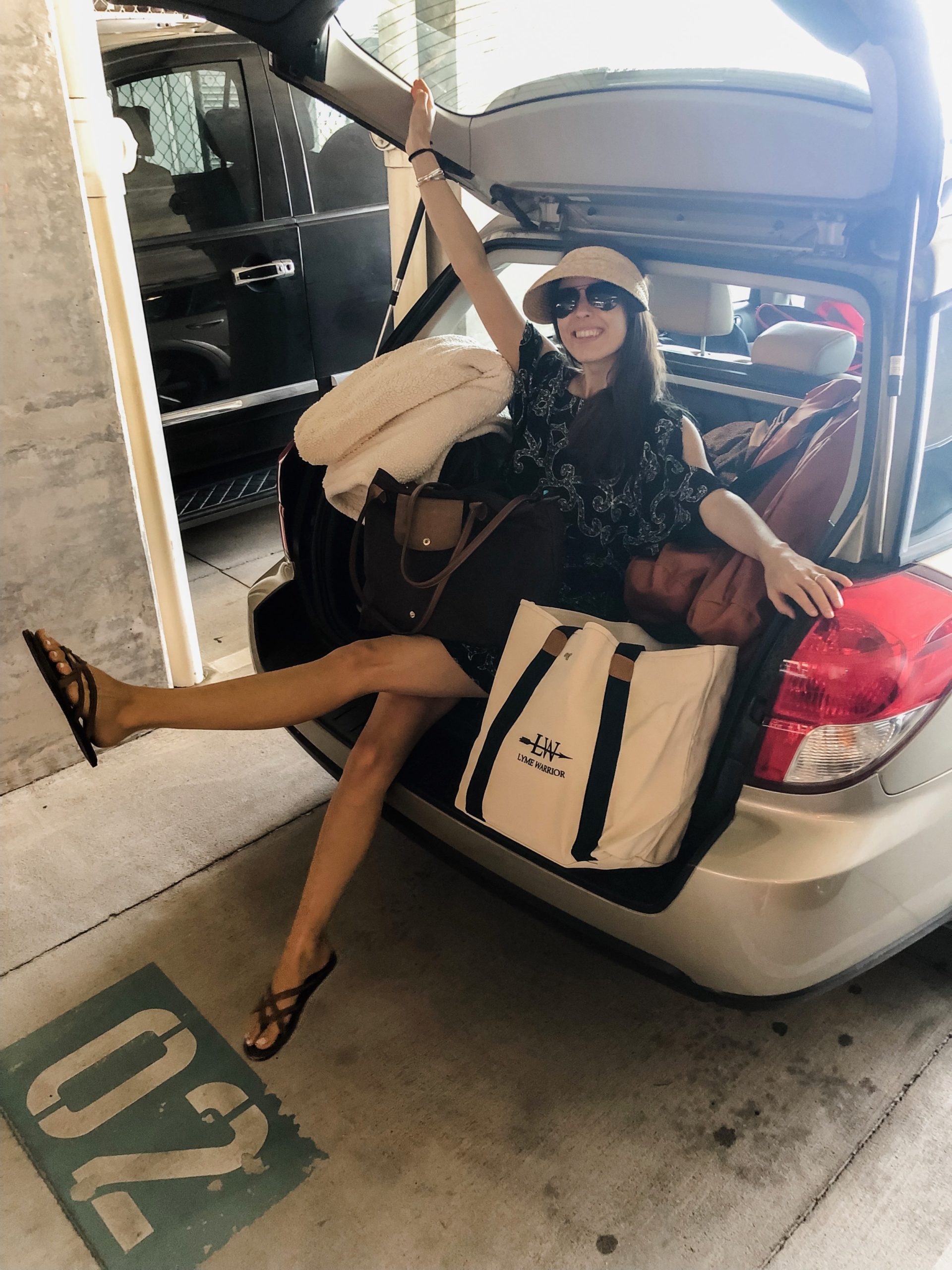8 Chronic Illness Road Trip Tips
Chronic illness adds layers of complication to any type of travel. I’ve found that road trips present a unique set of roadblocks (gettttttt it?) which are slightly different than air travel. Although there is often more room for accommodations, vehicle-based trips usually entail longer travel days and a wide variety of stimuli which can be downright exhausting.

Heaven. on. earth. Beach soul for life!
We recently took a road trip to the beach, which was a huge win! We’ve been wanting to get back to the Gulf Coast since our return to New Orleans last July, and it took almost a full twelve months to have a window of time and be in a place health wise where the trip felt manageable.
On the ride there (which takes about 4 hours), I had moderate symptoms and was able to brainstorm this list with my brother and fiancé. However, on way back I was riding shotgun on the struggle bus, with nausea and a full blown migraine, unable to brainstorm or do anything productive (or fun). This was extremely representative of the unpredictable nature of traveling with chronic illness. I always feel like I’m rolling the dice when we have a trip planned, and I find it impossible to predict how I’m going to feel or how physically arduous the journey will be.
Below are my top 8 tips for staying cool on the road no matter the “wtf-ery” your body throws your way:
1. Don’t mess around with light sensitivity preparedness
Be extra! The glare, sun and visual stimuli of a road trip is exponentially higher than my normal day to day. After years of not taking that fact seriously, because it didn’t “seem like that big of a deal”, I now over-prepare for increased visual stimuli and it has helped immensely. Non-negotiables in my car trip bag include a hat (love this visor), sunglasses (sometimes even double sunnies if I’m having a tough day) and a blanket or jacket to cover the window for weird sun/glare angles. I’ll crack the window a little bit, then secure a dark colored sweatshirt over the window as my “mobile blackout curtains”. When the light is killer, being able to block it makes a big difference in how triggering it is for my head pain.
2. Focus on what you can control

This is a good tip for life with chronic illness in general, but extra important on travel days. It’s so easy to spend the whole day focusing on all the things that are less than ideal or out of your control. I find it takes almost no effort to complain and focus on the negative and vent about things going “wrong”. However… I’m a firm believer in “where your attention goes, energy flows” and sometimes I literally have to cut myself off from negative thought spirals as an act of self preservation. It takes work to shift my thinking toward a more positive narrative, but when I focus my thoughts and speech on things that I do have control over (music, podcasts, snacks, my attitude, the sound level of people talking in the car, frequency of bathroom stops and walk-around-breaks, departure time, how much time I spend on my phone, eating at regular intervals) — my reality starts to feel like something that I am actively creating and I am more capable of handling any curveballs that get thrown my way.
3. Try not to freak out if you’re symptoms are flaring
This one is really tough. On top of the actual pain caused by a flare, if you’re like me, from the moment I wake up on a travel day, I struggle to control the anticipatory anxiety about how bad things could get or what I’ll do if pain kicks up. Road trips are a long haul, and if you happen to roll the dice and have a particularly symptom-y travel day, the emotional toll can be heavy. When this happens, I always remind myself that the more I freak out; the less I am helping myself. Although you have plenty of reasons to go down the freak-out-spiral when you’re staring down a day where you will be confined in the car and you feel like total crap, getting some control over your emotions by coaching yourself with positive self-talk can have a significant impact on how much you will suffer on top of the physical pain. When I am really hurting on a travel day, I adopt a “do what you gotta do” mentality for the day, give myself some grace and know that isn’t the norm. Sometimes this means more medication or being gentle through difficult emotions. No matter what it looks like, I try to do whatever I can for my mind and body to make things more bearable.
4. Pack a “go bag” separate from your travel bag

Purse to the left, “go bag” to the right.
For road trips I usually have 4-5 different bags packed (I try to keep them small!). I have a my regular purse where I carry my wallet, typical rescue meds, sunglasses, gum, essential oils, etc. I have my snack bag (duh). I have my bag to open once we reach our destination. And lastly, I have a “go bag”. This “go bag” is basically an expanded version of things I carry in my purse; I pack additional meds, easy snacks, comfy clothes that I can layer, extra water bottles, headphones and anything else I might need to access to make myself more comfortable. The last thing you want to do is feel like you don’t have all your tools within arm’s reach while stuck in the car for hours, and being strategic about organizing them can make a big difference.
5. Dress for the ride
Make sure you’re super comfortable, and don’t worry about how you look, at all! I cannot stress this point enough. If that means wearing pajamas, go for it. If it means wearing a dress that’s flowy so you can curl up in all kinds of positions in your seat, do it. Whatever it means to you, just make sure that your wardrobe is not adding any stress to your day. If you’re arriving somewhere where you want to look put together or just don’t want to look like a car-slob, pack extra clothes in your “go bag” to change into when you’re almost at your destination. Road trips with chronic illness are uncomfortable enough, there is no reason to add to that discomfort because you haven’t worn the most cozy ensemble you can imagine.
6. Travel Johns (!!!!!!!!!)
There are no words to describe what a truly remarkable product Travel Johns are. Order them on amazon right now (click here), put them in your car when they arrive — and thank me later. Living with a bladder disorder, these are absolute life savers for me. But they’ve been so useful on countless occasions for friends and family with whom I travel. They’re easy to use and can be stored under your seats. Just do it… you won’t be sorry.
7. Communicate clearly with your copilots (fellow travelers)
Speak up at the beginning of the trip and let your copilots know how you’re doing that day. What do you need to make the day as successful as possible? How can they help you? What’s your pain level like? You might feel like a burden, but being up front about what you’re experiencing can facilitate a much more pleasant trip for everyone. At home, I typically remove myself from situations triggering my pain and go rest in a quiet room when I need some space. Since that is not an option when sharing a car with others for hours, I’ve found that it’s better to over-communicate what is going on for me so that my companions aren’t surprised if I find myself struggling or need to ask them to lower their voices, turn down the music or make another stop. No matter how much the people you’re traveling with love you, they cannot read your mind! It’s up to you to communicate your needs as clearly as possible, and it is highly likely that this will help the day flow more smoothly.
8. Prepare, prepare prepare — accept.

No matter how hard it gets, you can and you will; because that’s what we do.
This is on every travel tip list I make. On the days that are so painful and grueling a trip feels unimaginable, acceptance is often the most powerful medicine. I’ve made it through every previous rough travel day that felt impossible, and learned over the years that no matter how bad the pain is — it can and will end (eventually). If it’s a “one moment at a time day” then do that, just go one moment at a time.
There will be days where you “do everything right” and still find yourself in pain. If it’s one of those days, you have to go into self-preservation mode. The most important thing you can do for yourself is to be accepting of what “is”. Remind yourself of the law of impermanence — that what are you experiencing in that moment cannot last forever and will change. Be forgiving of yourself as you strive for acceptance. As challenging as it can be, try to not make things harder for yourself by expecting, wishing or hoping that things would be different.
I hope these are helpful for you, please feel free to drop any of your tips below!
July 20, 2019
Meet Natalie
I share each step along my road to wellness and healing and hope that in doing so I can inspire you along your own path. Thank you so much for being here.
Just love this Nat! Really helps to see it in a nice list like this! I am trying the blackout window for my next car trip 🙂 keep spreading light
thanks so much girl! so hope it helps you some